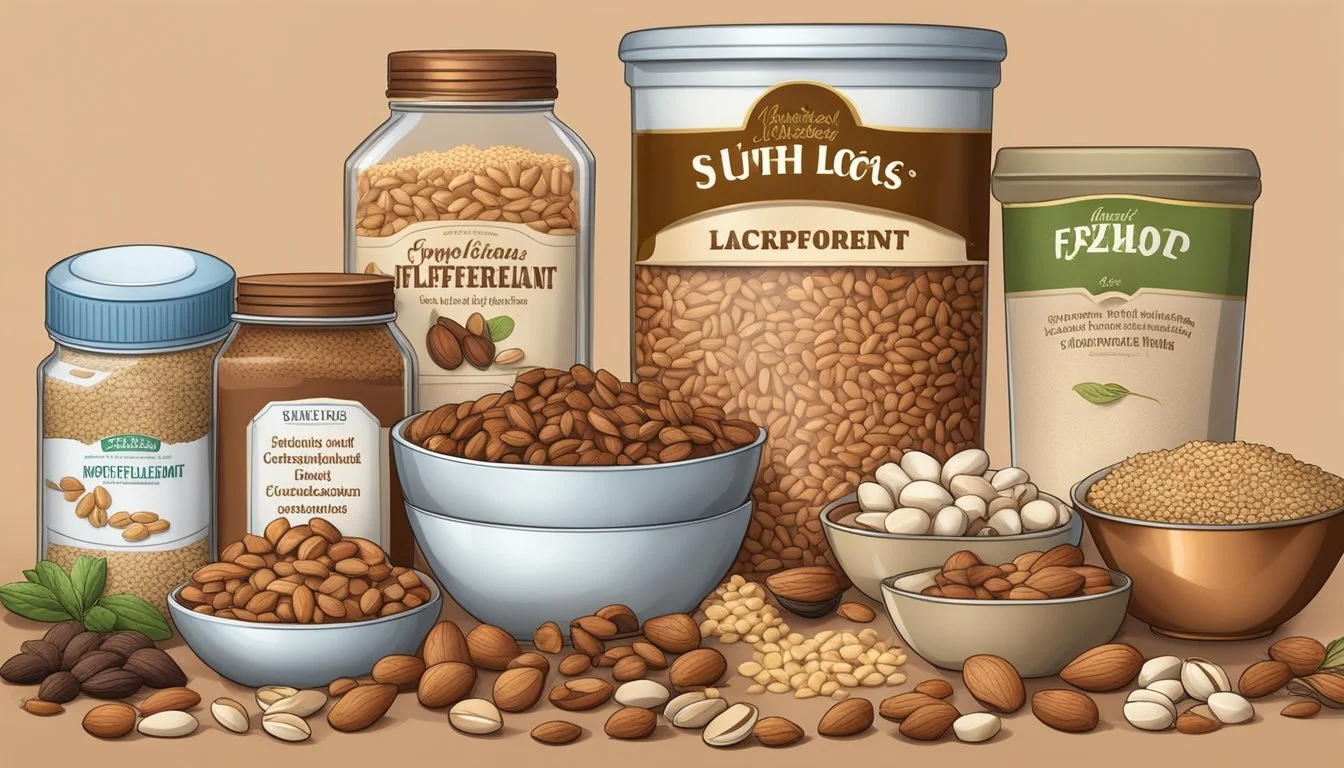How Can I Get Enough Copper on a Lactose-Intolerant Diet
Essential Strategies
For individuals with lactose intolerance, ensuring adequate nutrition can be a challenge, particularly when it comes to obtaining enough copper, which is essential for the body's overall health and function. Lactose intolerance arises from the inability to digest lactose, a type of sugar found in milk and other dairy products, due to the deficiency or absence of lactase, an enzyme produced in the small intestine. As dairy products are a common source of various nutrients, those avoiding dairy must seek alternative foods to meet their nutritional needs.
Copper is a trace mineral that plays a crucial role in the formation of red blood cells, helps maintain healthy bones, and supports the nervous and immune systems. While dairy is not a major source of copper, lactose intolerant individuals might worry about their overall nutrient intake when dairy is eliminated from their diet. However, numerous other foods can help in meeting the recommended daily intake of copper. These include nuts and seeds, whole grains, legumes, and even certain dark chocolate, making it possible to maintain a well-rounded diet even without consuming dairy.
Crafting a diet that compensates for the absence of dairy requires careful consideration of alternative copper sources. For people with lactose intolerance, it is imperative to include a variety of copper-rich foods to ensure they are getting an adequate amount of this essential nutrient. Balancing one’s diet with a mix of plant-based foods and possibly supplements, upon consultation with a healthcare provider, can help achieve the necessary nutrient levels for optimal health.
Understanding Lactose Intolerance
Lactose intolerance is a condition rooted in enzyme deficiency which leads to digestive symptoms. Testing for this condition involves specific procedures to confirm lactose malabsorption.
Causes of Lactose Intolerance
The inability to digest lactose, the sugar found in milk and dairy products, stems from a deficiency of lactase, an enzyme produced by the small intestine. There are different types of lactose intolerance:
Primary lactose intolerance: A common form, which results from a decrease in lactase production as part of the natural aging process.
Secondary lactose intolerance: Caused by injury or illness affecting the small intestine, such as celiac disease or Crohn's disease.
Congenital or developmental lactose intolerance: A rare form where lactase production is limited from birth.
Symptoms of Lactose Intolerance
Individuals with lactose intolerance typically experience:
Diarrhea
Gas
Bloating
Nausea
And, in some cases, vomiting
These symptoms may appear between 30 minutes and two hours after consuming dairy products. The severity of symptoms often depends on the amount of lactose ingested and the level of the individual’s lactase deficiency.
Lactose Tolerance Tests
To confirm lactose intolerance, healthcare professionals can administer tests such as:
Hydrogen breath test: After consuming a lactose-rich drink, the patient's breath is analyzed to measure the amount of hydrogen. High hydrogen levels suggest improper digestion of lactose.
Blood glucose test: This assesses the blood sugar level before and after lactose consumption to gauge absorption.
Stool acidity test may also be used, especially for children and infants.
Dietary Sources of Copper
Copper is an essential trace mineral crucial for various bodily functions. It is present in a wide array of foods, and incorporating a variety of these into one's diet can ensure an adequate intake.
Copper-Rich Foods
Certain foods are particularly high in copper. These include:
Organ meats: Liver, for instance, is one of the richest sources of copper.
Shellfish: Oysters and other shellfish contain significant amounts of copper.
Nuts: A handful of almonds or cashews can provide a substantial portion of the daily copper requirement.
Seeds: Sunflower and sesame seeds are good plant-based sources of copper.
Copper in Plant-Based Foods
Individuals who are lactose intolerant or prefer plant-based diets have numerous options:
Leafy greens: Vegetables like spinach and kale are not only high in nutrients but also contain copper.
Beans and lentils: These are excellent sources of copper, particularly for those following a vegetarian or vegan diet.
Tofu: This soy-based product is a versatile source of copper and can be easily incorporated into various dishes.
Copper in Fortified Foods
While naturally occurring copper in whole foods is ideal, some may benefit from foods enriched with nutrients:
Cereals: Many breakfast cereals are fortified with essential vitamins and minerals, including copper.
Copper-enriched products: Various market-available foods might be fortified specifically to address dietary copper intake.
It is important to include a diverse range of copper-containing foods in the diet to ensure adequate intake, especially for individuals with specific dietary restrictions such as lactose intolerance.
Managing Lactose Intolerance
For individuals with lactose intolerance, it is essential to modify their diet, consider supplements, and be vigilant about hidden lactose to effectively manage the condition.
Dietary Adjustments
Individuals with lactose intolerance should prioritize lactose-free or lactose-reduced products when constructing their diets. Dairy foods are the most common sources of lactose, but many alternatives are available:
Lactose-Free Milk: Completely devoid of lactose, suitable for consumption.
Plant-Based Milk: Include almond, soy, and coconut milk.
Hard Cheeses and Yogurt: These may have lower levels of lactose and be tolerable in small amounts.
It is advised to consult with a dietitian to create a balanced diet that provides sufficient nutrients while avoiding lactose.
Lactase Supplements and Probiotics
Available as over-the-counter tablets or drops.
Ingested with dairy foods to aid in the breakdown of lactose.
Probiotics:
Live bacteria and yeasts promoting a healthy digestive system.
Found in some yogurts and fermented foods, or as supplements.
May improve lactase production and gastrointestinal health.
Recognizing Hidden Lactose
Lactose can be present in unexpected places, so reading labels is crucial. People should look for terms that may indicate the presence of lactose in processed foods:
Whey
Curds
Milk by-products
Dry milk solids
Mayo Clinic suggests consulting with healthcare professionals to better understand label information and recognizing lactose in various products.
Additional Nutritional Considerations
For individuals navigating the challenges of lactose intolerance, achieving balanced nutrition requires attention to calcium and vitamin D, alternative sources of protein, and maintaining digestive health through probiotics.
Calcium and Vitamin D Intake
People who are lactose intolerant need to ensure they get enough calcium and vitamin D since they may avoid dairy products that are commonly fortified with these nutrients. Non-dairy sources of calcium include:
Green leafy vegetables: broccoli, kale, and bok choy
Fortified foods:
Calcium-fortified orange juice
Certain cereals
Soy milk
Nuts and seeds: almonds and sesame seeds
Beans and lentils
For vitamin D, which aids in calcium absorption, options are more limited, making fortified foods or supplements often necessary. Safe sunlight exposure and foods like fatty fish (such as salmon) can also contribute to vitamin D levels.
Alternative Protein Sources
Lactose intolerance can limit access to protein-rich dairy products. Individuals can turn to a variety of protein sources, including:
Fish and poultry
Beans, lentils, and legumes
Nuts and seeds
Tofu and other soy products
Lactose-free milk alternatives
Inclusion of these foods can help maintain muscle health and support the body's myriad functions requiring protein.
Digestive Health and Probiotics
A lactose-intolerant individual's digestive tract can benefit from probiotics, which support a healthy bacterial balance. Probiotics can be found in:
Fermented foods: sauerkraut, kimchi, and some yogurt alternatives
Supplements specifically designed for digestive health
Taking probiotics may alleviate some signs and symptoms of lactose intolerance and prevent bacterial overgrowth in the digestive tract.
Practical Tips for Lactose-Intolerant Diets
Being lactose intolerant doesn't mean one has to miss out on necessary nutrients or favorite foods. With a little knowledge and planning, it is possible to enjoy a varied and delicious diet without discomfort.
Reading Food Labels
One must scrutinize food labels to manage a lactose-intolerant diet effectively. Dairy products contain lactose, so one should look for phrases like "lactose-free" or "dairy-free" as indicators. It's crucial to check for hidden sources of lactose such as whey, curds, milk by-products, and dry milk solids. For those needing a dairy source of nutrients, seek out calcium-fortified and lactose-free options. Hard cheeses such as Parmesan and Swiss have negligible lactose and can generally be consumed without issue.
Shopping for Lactose-Free Alternatives
At grocery stores, one will find a variety of lactose-free alternatives that can replace traditional dairy products. Lactose-free milk is widely available and can be used in the same way as regular milk. When it comes to ice cream or cottage cheese, opt for lactose-free versions to enjoy these treats without discomfort. Other dairy-free alternatives like almond, soy, and rice milk are also nutritious options. When in doubt, ask a store manager or dietitian to guide you towards lactose-free choices.
Cooking and Meal Planning Tips
During meal planning, one can easily substitute lactose-free dairy products such as lactose-free cottage cheese or cream cheese into recipes. Experiment with dairy substitutes in cooking, such as using nutritional yeast to mimic a cheesy flavor or coconut cream in place of heavy cream. Have a prescription for lactase enzyme supplements? They may allow you to enjoy lactose-containing foods by helping digest the lactose. In recipes calling for soft cheeses, consider using lactose-free or harder aged cheeses which have lower lactose contents.
When to Consult Healthcare Professionals
Individuals with lactose intolerance must navigate dietary choices carefully to maintain sufficient nutrient intake, including copper. Consulting healthcare professionals can provide guidance on dietary modifications, help address any deficiency symptoms, and monitor related health conditions.
Seeking Dietary Advice
Those unsure about adjusting their diet to meet copper needs should consult a dietitian. Dietary professionals can suggest lactose-free foods high in copper, such as:
Seafood
Nuts and seeds
Whole grains
Organ meats
Dark chocolate
A tailored plan accommodates not only lactose intolerance but also accounts for an individual's cultural and dietary preferences, whether Asian, Hispanic, African, or other backgrounds.
Addressing Deficiency and Symptoms
Lactose intolerance, particularly in adulthood, can lead to nutrient deficiencies and gastrointestinal symptoms like bloating and discomfort. If one experiences persistent symptoms despite dietary changes, a healthcare provider might investigate for lactase deficiency or secondary issues like celiac disease. They may recommend specific medications or supplements to address these symptoms effectively.
Monitoring Health Conditions
Regular monitoring is crucial, especially for individuals with a primary or secondary form of lactose intolerance, to ensure their diet provides essential nutrients while managing symptoms. Regular check-ups with a medical professional help keep track of one's overall health and the effectiveness of dietary or medicinal interventions.








